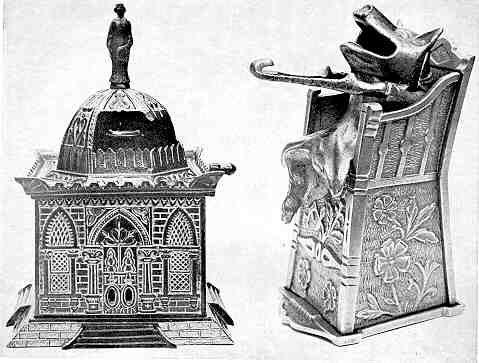Mosque Bank & Pig In High Chair Bank
by F.H. Griffith - HOBBIES Magazine - March, 1970

The largest and most imposing of the Judd line of mechanical banks is our choice as No. 179 in the numerical classification. This is known as the Mosque Bank, which name is reasonably descriptive of this finely detailed sizeable building type mechanical bank. As a matter of fact, the Mosque is one of the largest in the building group. We have mentioned in previous articles that the Judd line of mechanicals is unusual as compared to those of other companies. Unusual, too, is the size of this bank as compared to the general line produced by Judd. All of their banks are quite small with the exception of the Mosque — a bank with a rather impressive appearance.
The H. L. Judd Company apparently did not do much in the way of patenting their mechanicals. Like most of their banks, no patent papers have been discovered to date that would apply to the Mosque. Again, however, an old Judd catalog is helpful in placing the date of the bank in the 1880’s. With respect to the Judd Company and information concerning same, please see HOBBIES articles for April, 1963, and March, 1966.
The bank shown, Figure 1, is in excellent original condition. Found in New England the bank has been in the writer’s collection for years. Like all Judd banks with their several colors of lacquer type finish, the Mosque is an overall brownish color. All the fine lines of the extraordinary casting detail on the building, including the dome, are done in gold. The figure inside the dome and on top of the dome are finished in the brown lacquer only, and this completes the decoration of the bank.
The operation is effective but simple. The figure inside the dome holding a tray over its head is positioned to the front of the bank (see photo) by means of a crank on the side of the building. A coin is placed on the tray and the crank when turned clockwise causes the figure to move counter-clockwise inside the dome. The figure encounters a section which causes the coin to slide off the tray into a trough dropping inside the building.
It would be interesting to know what the designers of the Mosque Bank had in mind with respect to subject matter. The figure inside the dome is somewhat grotesque and it’s difficult to tell just what animal it represents. More than anything else, it would seem to represent a bear — it could be a monkey or a gorilla, however. The figure of the woman on top of the dome holds a wreath in her left hand, possibly representing peace or an award. In any event, it’s a rather interesting bank with excellent casting detail and unique appearance.
* * *
The often heard term of "Piggy Bank" can seldom be used with reference to mechanical banks. As we reach No. 180 in the numerical classification we have chosen a bank that could possibly be referred to as such — the Pig In High Chair. Curiously enough very few pigs are represented in the old mechanicals. Transversely, in the modern category of mechanicals, there are a number of pig types, including the satiric World War II Hitler Squealing Pig.
The most desirable and outstanding of the mechanical banks to utilize a pig is the rare Bismark Bank (HOBBIES, March, 1956) and then, of course, the popular Paddy And The Pig (HOBBIES, April, 1965). Now we come to a baby pig feeding in a high chair.
The Pig In High Chair was patented August 24, 1897, by Peter Adams of Buffalo, NY., assignor of one-half to Walter Shepard, also of Buffalo. This, of course, would normally have direct connections to the Shepard Hardware Company as being the manufacturer. However, the bank was actually made by the J. & E. Stevens Company of Cromwell, Conn., and pictured in various of their catalogs of the period.
The Pig In High Chair, Figure 2, is in practically mint condition. It is an overall nickel plate finish and this is the only way this bank was made — never painted in colors.
To operate the bank a coin is placed on the tray and a lever in the back of the high chair is pressed down. This causes the tray to lift up and the coin slides therefrom on into the open mouth of the pig. As this action takes place the tongue of the pig also moves upward allowing the coin to drop inside.
The Pig In High Chair leaves some collectors rather ‘cold.’ They do not particularly like it, but must have one in their collection. Actually it’s sort of a "cute" type bank, very well made, and somewhat attractive.
